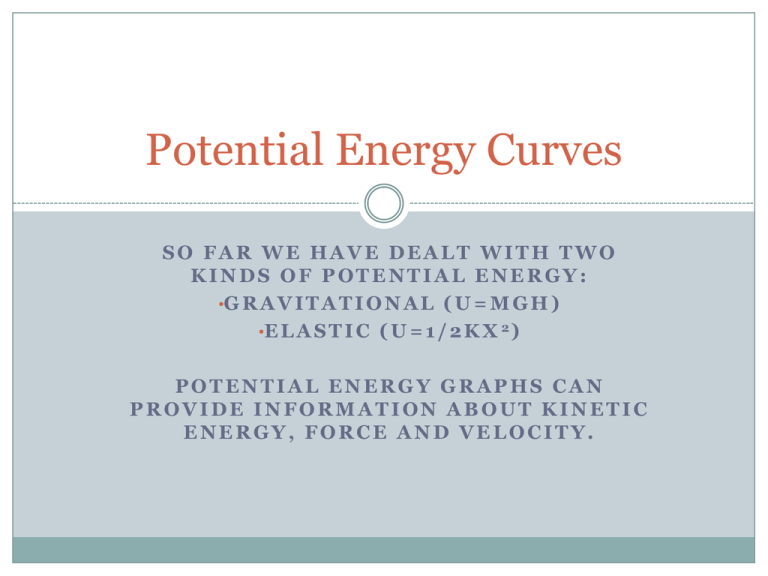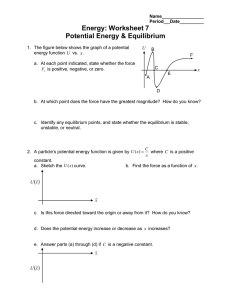Potential Energy Curves
advertisement

Potential Energy Curves SO FAR WE HAVE DEALT WITH TWO KINDS OF POTENTIAL ENERGY: •G R A V I T A T I O N A L ( U = M G H ) •E L A S T I C ( U = 1 / 2 K X 2 ) POTENTIAL ENERGY GRAPHS CAN PROVIDE INFORMATION ABOUT KINETIC ENERGY, FORCE AND VELOCITY. Force and Potential Energy We established that the relationship between work and potential energy was: W U which leads to… F x U U F x Force and Potential Energy which leads to…. dU F dx d Fg mgh mg dx d 1 2 Fs kx kx dx 2 A conservative force always acts to push the system toward a lower potential energy. For example: Example A FORCE PARALLEL TO THE X -AXIS ACTS ON A PARTICLE MOVING ALONG THE X AXIS. THE FORCE PRODUCES A POTENTIAL ENERGY: U ( X ) = 1 . 2 X 4. WHAT IS THE FORCE WHEN THE PARTICLE IS AT X=-0.8M? Force and Potential Energy This analysis can be extended to apply to three dimensions: U ˆ U ˆ U F i j y x x kˆ Potential Energy Curves for a Spring Note: When the spring is either in a state of maximum extension or compression its potential energy is also a maximum When the spring's displacement is DOWN the restoring force is UP When the potential energy function has a negative slope, the restoring force is positive and vice-versa When the restoring force is zero, the potential energy is zero At any point in the cycle, the total energy is constant: U + K = Umax = Kmax Points of Equilibrium When the force acting on the object is zero, the object is said to be in a state of EQUILIBRIUM! STABLE EQUILIBRIUM – located at minimums, if the object is displaced slightly it will tend back to this location. UNSTABLE EQUILIBRIUM – located at maximums, if the object is displaced slightly it will tend away from this location. STATIC EQUILIBRIUM – located at plateaus, where the net force equals zero. Points of Equilibrium Stable Equilibrium at x3 and x5. Unstable Equilibrium at x4. Static Equilibrium at x1 and x6. Turning Points Define the boundaries . of the particle’s motion. We know that E=K+U, so where U=E, K=0 J and the particle changes direction. For instance, if E=4J, there would be turning point at x2. Turning Points If E = 1J, why is the grey area referred to as an “energy well”? Example A particle of mass 0.5 kg obeys the potential energy function: U(x) = 2(x - 1) - (x - 2)3 What is the value of U(0)? What are the values of x1 and x2? Example A particle of mass 0.5 kg obeys the potential energy function: U(x) = 2(x - 1) - (x - 2)3 How much potential energy does the particle have at position x1? If the object was initially released from rest, how fast is it moving as it passes through position x1? Example A particle of mass 0.5 kg obeys the potential energy function: U(x) = 2(x - 1) - (x - 2)3 How much potential energy does the mass have at x2? How fast is it moving through position x2? Example A particle of mass 0.5 kg obeys the potential energy function: U(x) = 2(x - 1) - (x - 2)3 Which position, x1 or x2, is a position of stable equilibrium? Example A particle of mass 0.5 kg obeys the potential energy function: U(x) = 2(x - 1) - (x - 2)3 How fast is the particle moving when its potential energy, U(x) = 0J? If x3 = ½x1, then how fast is the particle moving as it passes through position x3? Example A particle of mass 0.5 kg obeys the potential energy function: U(x) = 2(x - 1) - (x - 2)3 Sketch the graph of the particle's acceleration as a function of x. Indicate positions x1 and x2 on your graph.




